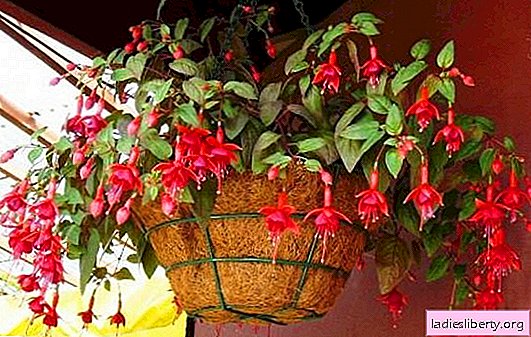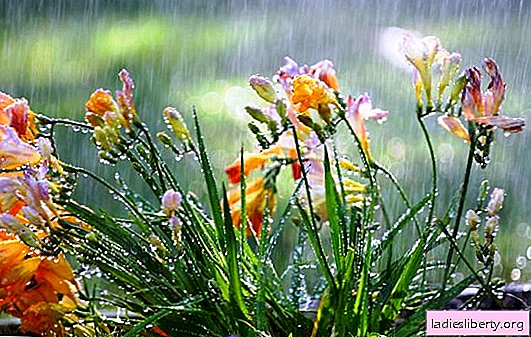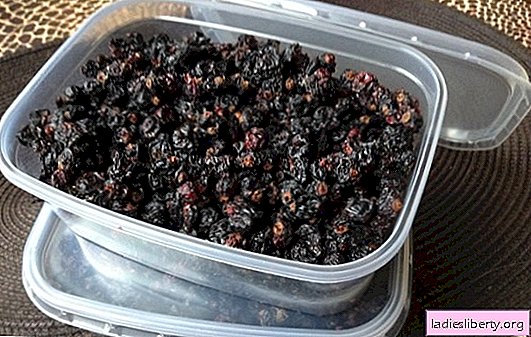
Fuchsia was loved by home growers for its unpretentiousness in care and the ability to bloom in the first year of planting.
"Ballerina" - that’s what the name the plant got for its delicate, bizarre form of inflorescence.
If you transfer the flower to a bright, cool room for the winter, it will delight you with its look in the next season.
Fuchsia is a true long-liver. Providing the plant with proper care, it can decorate your home for up to 20 years.
Fuchsia can be planted with seeds, cuttings and leaves.
Choose varieties of fuchsia for growing
Fuchsia is very "universal." It is suitable for growing in open ground, in hanging flower pots, in drawers and pots - everywhere it takes root well. The flower is often used by designers for landscaping greenhouses and flower beds - the number of shades and shapes is amazing!
When choosing a suitable variety, pay attention to the type of plant - fuchsia can be bush and ampelous. The ampelous look is more suitable for vertical gardening - its shoots beautifully fall down. For growing at home, if you, of course, have not intended to decorate an open balcony in this way, it is better to choose more compact flower shapes.
Many varieties (over 20,000) of fuchsia have already been bred.
Pay attention to the following beautiful varieties of plants:
• Deep purple Variety with drooping shoots. The flowers are large, double, bright blue-violet with white sepals.
• Marcus Graham. Bush fuchsia with huge terry inflorescences. The flowers are bright pink with pale pink sepals.
• Maxima. The bush form of the plant, famous for the early onset of flowering. The inflorescence is semi-double, black-purple with dark pink sepals.
• Moonraker. Fuchsia resistant to disease and pests. Grows in the form of a compact bush. Inflorescences are terry, pale blue with white and pink sepals.
• Anabel. Flower with weakly penetrating stems. Inflorescences are semi-double, white with light pink sepals.
• Checkerboard. An upright plant suitable for standard growing. Inflorescences - with pointed petals, red with white sepals.
• Bella Rozella. The variety is intended for ampel growing. The flowers are terry, pink.
• Brutus. Bush plant. The inflorescence is saturated scarlet with light pink sepals.
• Leonberg. The variety is suitable for standard cultivation. The flowers are large, pink with coral sepals.
Have you already chosen a suitable cultivar of fuchsia? Now we will decide on the method of planting it and prepare a place for a new "resident" of the windowsill.
Soil and container for growing fuchsia
Fuchsia is not too whimsical to the soils - a light fertile soil with a neutral reaction is suitable. To make the soil more loose, add peat, sand and perlite to the earthen mixture. And adding a small amount of clay will help to retain nutrients in the earth longer, which will increase the flowering time. In the gardening shop you can buy nutritious soil for perennial flowering plants - it is quite suitable.
To grow fuchsia, pick up a light ceramic pot - so its sensitive roots will not overheat. In the future, the flower will need to be replanted annually, which will require the availability of a new capacity 1-3 cm larger in diameter than the previous one.
Planting Fuchsia Seeds
Reproduction of the function by seeds has not received wide distribution among gardeners - largely due to the fact that a small assortment of seeds is presented in stores, it is difficult to get them. And if you have been successfully growing a plant at home for several years now, you can become a breeder for a short time by collecting seeds yourself for further cultivation. But be prepared for the fact that the new flower may be strikingly different from its "parent" - both in shape and color.
Planting a plant start in February. For home cultivation, you can plant the seeds immediately in a pot. Sowing technology is as follows:
• Put the soil in the pot, tamp it lightly and moisten (preferably with a potassium permanganate solution).
• Slightly dig the seeds into the soil without sprinkling them on top of the ground.
• Cover the container on top with glass or polyethylene.
Fuchsia will sprout at a temperature of + 18 ... +22 ˚C in partial shade. Periodically shake condensation from cover. When drying the soil - moisten it a little. Not later than in a month you will see the first sprouts above the surface of the earth - the shelter can be removed. If you pre-make seedlings, then closer to summer seedlings dive first in the stage of 2-4 full-fledged leaves, and then are transferred to a permanent place.
Planting fuchsia cuttings
Planting fuchsia with cuttings is the most popular propagation method among gardeners. Pick up a fuchsia stalk from your friends at the horticultural market or get a friend. Pay attention to the appearance of planting material:
• shank length - 10-25 cm,
• leaflets - without spots and dry ends,
• the top of the central shoot - not pinched or damaged,
• roots - developed, without signs of disease.
It is better to take young shoots for planting, since already lignified cuttings give roots much later.

Fuchsia Shank, Ready for Rooting
Start rooting cuttings in the spring. In summer, the process can be hindered by intense heat - fuchsia does not like this. Well, in the fall, the plant is at rest - you can never wait for the roots to appear. Plant shoots either immediately in the soil or in water. When rooting in water - cut the bottom leaves on the handle so that they do not rot in a humid environment and do not infect the entire plant. If you planted an escape in the ground, cover it with a jar for the first weeks.

Rooting Fuchsia Shank in Water
The seedling will take root in 10-14 days. Soon your beauty will bloom magnificently. It makes no sense to treat the shoots with special root-forming agents - fuchsia will easily adapt to a new habitat.
In the future, you can take young shoots of a plant already from your plant.
Fuchsia: leaf cultivation
To grow fuchsia from a leaf, you need a large leaf, on which there should be a petiole and part of the shoot with a kidney. Planting material is rooted in a nutrient substrate - moss, vermiculite, peat (2: 3: 1).
The technology is as follows:
• Place the substrate in a seedling box or a separate pot, moisten it slightly.
• Make a small depression in the mixture and place a leaf here, lightly sprinkle the stalk with a substrate without crushing it.
• Cover the container with glass or a bag.
If the substrate dries, lightly water it along the edge. And after 10-20 days, the leaf will take root. After this, you can transplant the seedling to a permanent place.
Fuchsia: growing and care
Even novice growers can cope with the care of fuchsia. It is important to remember the following rules:
• Temperature. Fuchsia does not like intense heat - inflorescences and leaves fade, begin to fall. The optimum temperature for growing fuchsia is 18-25 ° C. At a higher temperature, flower growth will slow significantly, the bush will dry out.
• Lighting. So that the direct rays of the sun do not fall on the plant, pick it a place in partial shade. If you grow fuchsia at home, select the window sill on the window facing the west or east side. When the plant blooms, there is no need to turn or turn it away from the sun - fuchsia can throw off all the buds.
• Watering. Water the fuchsia liberally when the earth in the pot begins to dry. Take the settled fluid that will not damage the root system. Reduce watering for the winter to 1-2 times per month. When it is warm outside, you can spray leaves and inflorescences with spray water (you can several times a day). And before flowering begins (in spring-summer), in order to ensure fuchsia the desired level of humidity, put a container of water near the pot.
• Top dressing. Growing fuchsia in open ground, regularly fertilize it with biological fertilizers. At home, use ready-made dressings that can be bought at flower shops. Fertilize plants once a week. In winter (starting in September) fuchsia supplements are no longer needed.
• Transfer. Transplant fuchsia every year, picking up a new container with a larger diameter. When replanting an old plant, you can clean the roots and completely change the soil. Transfer the young fuchsia (up to 3 years old) to a new container with the old earth, only adding a little more to the top layer to completely fill the pot.
An important point in caring for fuchsia is forming trim. Cutting off the "extra" shoots and removing faded buds from the bush, you will not only give the plant a decorative look, but also improve it - the root system will not waste nutrients. Be sure to cut fuchsia 2 times a year - in spring and autumn.
Spring pruning is carried out in March - cut dead shoots, pinch new ones. September pruning is needed in order to prepare the flower for wintering. In this case, shorten the old branches 2/3, and the shoots of this year - 1/3.

Fuchsia Spring Trimming
Growing fuchsia at home, it is not necessary to create special conditions for her for the winter - she will calmly survive the cold and so on. But be sure to transfer garden plants to a cool room.
Why is fuchsia not blooming?
Fuchsia does not bloom only if important rules for caring for it have been violated. Cases are so rare. For a note, a beginner grower consider them:
• late pinch,
• choosing too hot a place to grow,
• the introduction of a large amount of nitrogen in the form of fertilizing,
• diseases and pests,
• growing in a plastic or too small pot.
When you eliminate the negative factors, fuchsia will delight you with magnificent and long flowering.
Fuchsia: growing. Diseases and Pests
Even at room conditions, fuchsia can be affected by diseases and pests. Do not rush to throw away the “sick” plant - for sure it can still be cured.
Dangerous insect pests for fuchsia:
• Whitefly The most common bug that affects beautiful fuchsia. You will notice it immediately on the white wings - the whitefly looks like a moth. Entire "flocks" of pests (both adults and larvae) accumulate on the inside of the leaves.
The insect is dangerous because it depletes the plant, eating leaf juice - the flowers are smaller, the leaves are yellower and fall off. It also carries fungal and viral diseases.
Insecticides for watering plants show good results when fighting whiteflies - leaf juice becomes "inedible" for insects. If you began to use special tools, alternate them.
Many gardeners stick sticky strips near the flower, but they will not save with a large accumulation of insects on the sheets.

Whitefly on a leaf
• Red spider mite. This is a small reddish insect that settles on the inside of fuchsia leaves.
The tick feeds on the juice of the plant, and pale spots appear on the foliage. If measures are not taken in time, the green mass may completely turn yellow and fall.
Most often, the pest appears on fuchsia, which is often not watered.
Insecticides and the complete removal of affected leaves cope with tick infestations. For prophylaxis, often spray fuchsia with warm water.

Red spider mite
Fuchsia is not often affected by the disease. But many of them threaten the complete death of the flower:
• Rotting of the roots. If you regularly moisturize fuchsia, a fungus will hit its roots. In this case, the plant quickly dies. It is unlikely to save fuchsia - even cuttings taken from it will not take root. Throw away the flower and the ground in which it grew. This is especially important when growing fuctions in the open ground - if you do not remove the carriers of the infection, all the nearest specimens can get sick.
• Rust on the leaves. The disease is borne by fungi. It is more common in open areas, and at home rarely affects the flower, only if the humidity is very high. Settling on the leaves, the spores of the fungus cause severe damage. In appearance, they look like a brownish-orange coating. If you notice "rusty" leaves, immediately remove them from the plant. For prevention, treat fuchsia with a 2% solution of Bordeaux fluid. With the appeared fungus, fungicides can cope.

Rust on the leaves
Take care of fuchsia and protect it - no insects and diseases will be at all afraid of it!











